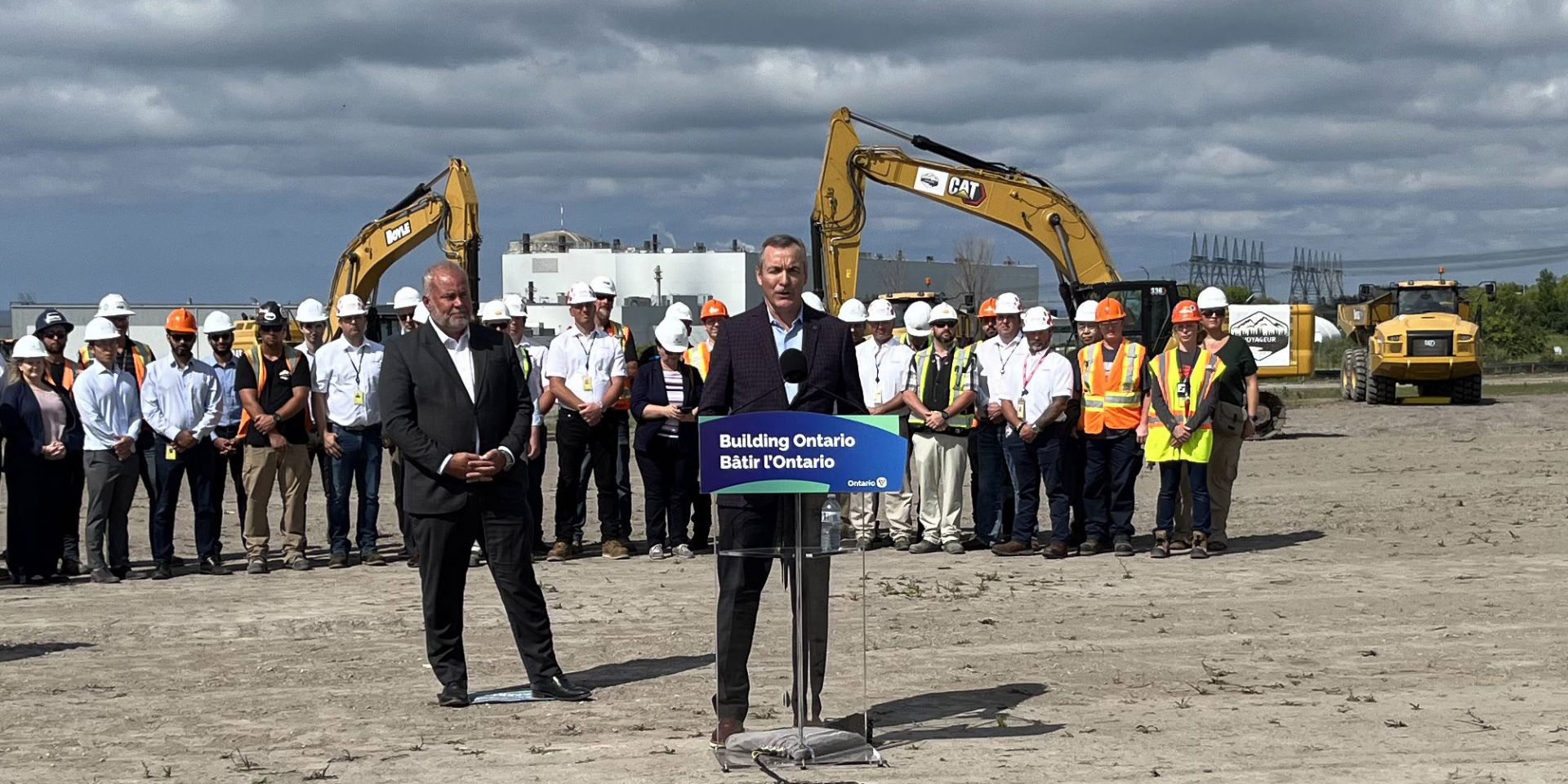The Palisades nuclear power plant. (Photo: Entergy)
Holtec International has taken another step on the arduous stairway to Palisades resurrection, announcing last Friday that it has filed with the Nuclear Regulatory Commission to “formally begin the process of seeking federal reauthorization of power operations” at the Covert Township, Mich., facility.
PUCT commissioner Jimmy Glotfelty leads the discussion at the Texas Advanced Nuclear Reactor Working Group’s first public meeting, on September 28. (Image: PUCT)
The Texas Advanced Nuclear Reactor Working Group—formed recently by the Public Utility Commission of Texas (PUCT) at the direction of Gov. Greg Abbott—hosted its first public meeting last Thursday to discuss the group’s organizational structure and outline a plan to turn Texas into a national leader in the use of advanced nuclear energy.
Support from the government of Alberta for the Cenovus Energy SMR study was announced September 19 at the World Petroleum Congress in Calgary. From left are Laura Kilcrease, Alberta Innovates CEO; Rhona DelFrari, Cenovus chief sustainability officer and executive vice president, stakeholder engagement; Rebecca Schulz, minister of environment and protected areas; Justin Riemer, Emissions Reduction Alberta CEO; and Nathan Neudorf, minister of affordability and Utilities. (Photo: Government of Alberta)
Canada’s Alberta province is investing C$7 million (about $5.2 million) to help Cenovus Energy study how small modular reactors could be used in northern Alberta to decarbonize oil sands production and what additional information might be needed to pursue their regulatory approval.
U.S. principal deputy assistant secretary of state for international security and nonproliferation Ann Ganzer (right) with Nii Kwashie Allotey of the Ghanaian Nuclear Regulatory Authority (center). (Photo: U.S. Embassy in Ghana )
The U.S. Embassy in Ghana last week announced $1.75 million to support establishing the West African nation as a small modular reactor regional training hub and center of excellence for the sub-Saharan African region.
The project is backed by the Foundational Infrastructure for Responsible Use of Small Modular Reactor Technology (FIRST) capacity-building program, in which Ghana has participated since 2022.
Westinghouse president and CEO Patrick Fragman (seated at left) and Energoatom president Petro Kotin (seated at right) sign an MOU on AP300 deployment in Ukraine. Standing behind Fragman and Kotin is Ukrainian energy minister German Galushchenko. (Photo: Energoatom)
Westinghouse Electric Company and Ukraine’s nuclear operator Energoatom have signed a memorandum of understanding on the development and deployment of the American firm’s AP300 small modular reactor in the Eastern European state.
The Palisades nuclear power plant.
Holtec International’s ongoing effort to repower Michigan’s closed Palisades nuclear plant made progress this week with the signing of a power purchase agreement (PPA) between the firm’s Holtec Palisades Energy LLC subsidiary and Wolverine Power Cooperative, a not-for-profit energy provider to the rural communities across Michigan.
A cutaway image of the BWRX-300. (Image: GE Hitachi Nuclear Energy)
The Canadian government continued advancing its small modular reactor action plan on Saturday with the approval of up to C$74 million (about $54.6 million) in federal funds for SMR development in Saskatchewan, led by the province’s main electricity provider, SaskPower.
Texas Gov. Greg Abbott (right) talks nuclear energy at UT-Austin on August 16. With Abbott are X-energy chief executive officer Clay Sell (left) and Dow chair and CEO Jim Fitterling. (Photo: Office of the Texas Governor)
Texas Gov. Greg Abbott sat down with X-energy chief executive officer Clay Sell and Dow chair and CEO Jim Fitterling last week for a “fireside chat” at the University of Texas–Austin on the role of nuclear energy and technology in the state.
Marking the NRC’s acceptance of NuScale’s standard design approval application for formal review are, left to right, Getachew Tesfaye, NRC senior project manager; Robert Gamble, NuScale vice president of engineering; Brian Smith, NRC director of the Division of New and Renewed Licenses; Carrie Fosaaen, NuScale vice president of regulatory affairs; Karin Feldman, NuScale vice president of the program management office; Robert Taylor, NRC deputy office director for new reactors; and Mark Shaver, NuScale director of regulatory affairs. (Photo: NuScale)
The Nuclear Regulatory Commission has accepted for formal review NuScale Power’s standard design approval (SDA) application for its updated small modular reactor design, the Portland, Ore.–based firm announced yesterday.
Concept art of the six-module Carbon Free Power Project, to be sited at INL. (Image: NuScale)
CFPP LLC, the limited liability company established by Utah Associated Municipal Power Systems (UAMPS) in 2020 to bring its Carbon Free Power Project to fruition, has applied to the Nuclear Regulatory Commission for a limited work authorization (LWA) to permit certain early project construction activities prior to the issuance of a combined license (COL). In a July 31 news release, CFPP said that should its application be approved, early-scope construction on the small modular reactor project would likely begin in mid-2025.
Ontario energy minister Todd Smith (left) and Ontario Power Generation president and CEO Ken Hartwick announce plans for three more BWRX-300 units at Darlington. (Photo: OPG)
If we’re in a new nuclear renaissance, its capital would appear to be Ontario. On July 7, just two days after debuting a collaboration with Bruce Power to build up to 4.8 GW of new nuclear generation at the Bruce plant, the government of Ontario announced that it is working with Ontario Power Generation to begin planning and licensing for the deployment of three additional GE Hitachi Nuclear Energy (GEH) BWRX-300 small modular reactors at that utility’s Darlington site.
A map of Norway (green) and Finland (blue). (Image: Wikimedia Commons)
Consulting company TVO Nuclear Services (TVONS), a subsidiary of Teollisuuden Voima Oyj, owner and operator of Finland’s three-unit Olkiluoto nuclear plant, has signed a memorandum of understanding with Norsk Kjernekraft, aka Norwegian Nuclear, a firm established last July with the goal of bringing small modular reactors to power reactor–deprived Norway.
A June 27 announcement from TVO said the new MOU provides the Norwegian firm with “access to the know-how and experience of one of the world’s best-known nuclear power companies” and stressed TVO’s 60 percent ownership of Posiva, the company responsible for the disposal of Finland’s spent nuclear fuel. “Posiva has successfully built the world’s first final disposal facility for high-level nuclear waste,” TVO stated. “This is decisively important for Norwegian Nuclear’s plans for the management of the entire life cycle of nuclear power.”
















